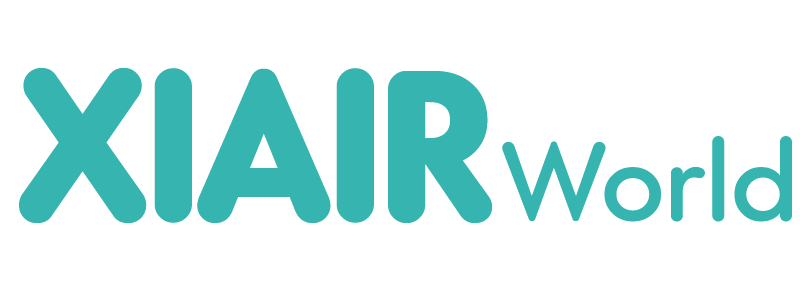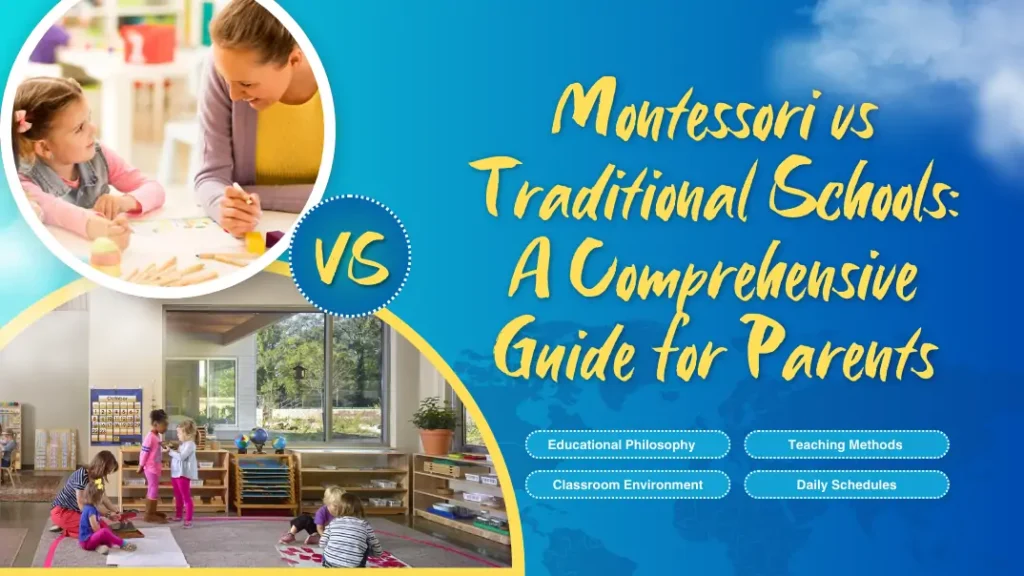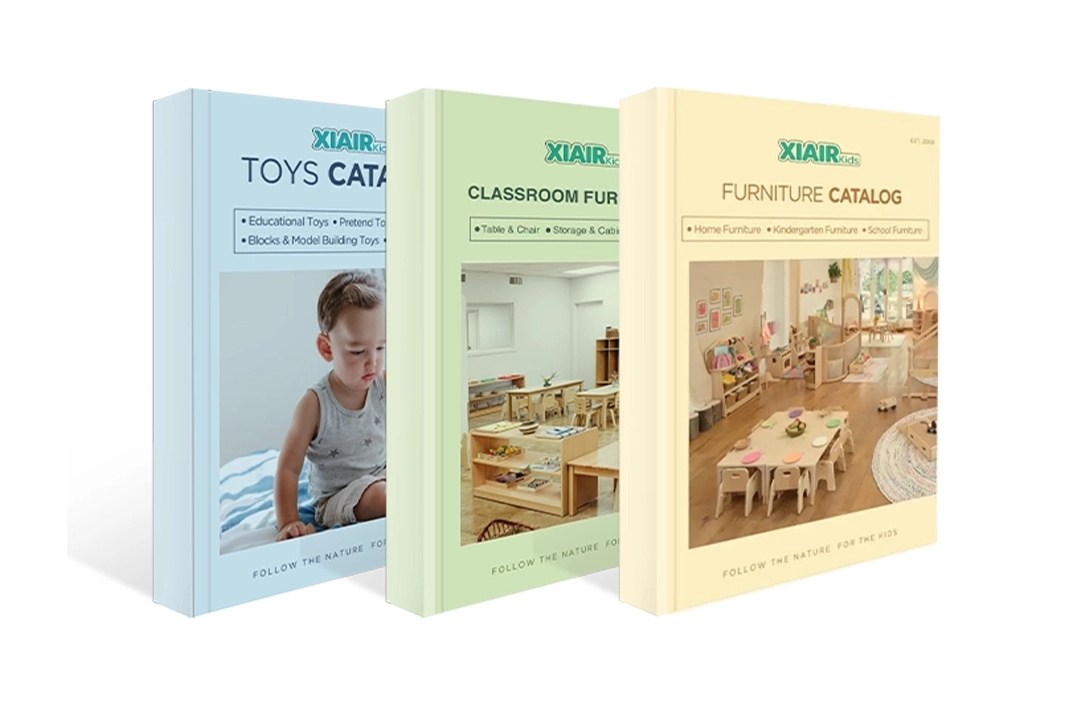Are you trying to decide between Montessori and traditional education for your child? The choice between Montessori vs traditional schooling is crucial to shaping your child’s educational journey and future. Understanding the key differences can help you choose your child’s needs and educational goals best.
In brief, Montessori education emphasizes child-led learning and independence, while traditional education focuses on a structured curriculum and teacher-led instruction. Both methods have unique strengths and challenges.
It’s essential to delve deeper to understand which method best suits your child. Let’s dive into the key differences and advantages of each.
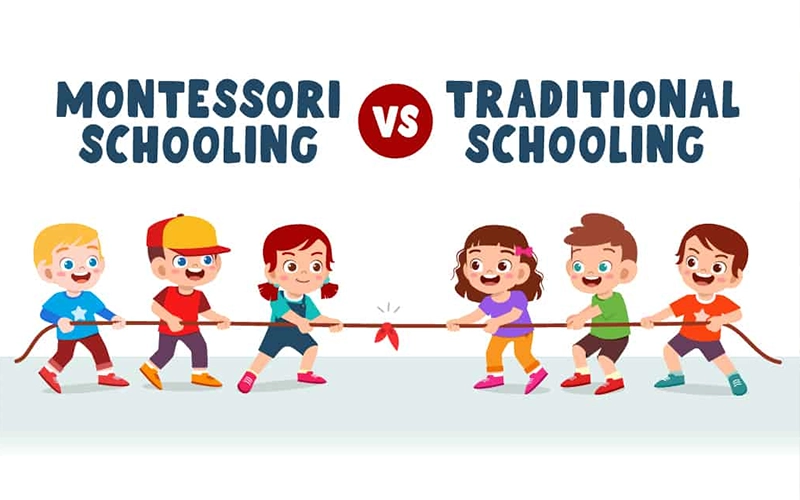
What are the Differences Between Montessori and Traditional Education?
Are you trying to decide between Montessori and traditional education for your child? Understanding the key differences can help you choose your child’s needs and educational goals best.
In brief, Montessori education emphasizes child-led learning and independence, while traditional education focuses on a structured curriculum and teacher-led instruction. Both methods have unique strengths and challenges.
Let’s explore the main differences in detail.
Educational Philosophy
Montessori Approach
- Child-Centered: Montessori education is rooted in the philosophy of Dr. Maria Montessori, emphasizing respect for the child’s natural development. The approach sees children as naturally eager for knowledge and capable of initiating learning in a supportive, thoughtfully prepared learning environment.
- Self-Directed Learning: Encourages children to learn through exploration and discovery, fostering intrinsic motivation. Children choose their activities from various options, allowing them to follow their interests and work at their own pace.
- Holistic Approach: Focuses on developing the whole child – emotionally, socially, and intellectually. This includes life, social, and practical skills, integrating them seamlessly into the educational experience.
Traditional Approach
- Standardized Curriculum: Based on a structured educational system aimed at preparing students for academic and societal success. The curriculum is designed to cover a broad spectrum of subjects, ensuring all students receive a comprehensive education.
- Teacher-Led Instruction: Emphasizes a more directive approach where the teacher delivers content to the entire class. This method ensures that all students are exposed to the same material simultaneously.
- Assessment-Driven: Focuses on meeting educational standards and benchmarks through systematic evaluation. Tests, quizzes, and standardized exams are commonly used to measure student progress and understanding.
Montessori philosophy nurtures independence and holistic development through self-directed learning, while traditional education prepares students for societal norms with a structured and assessment-driven approach.
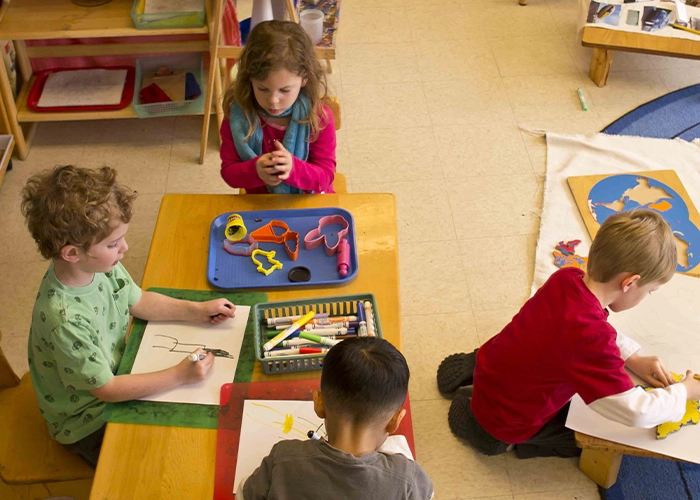
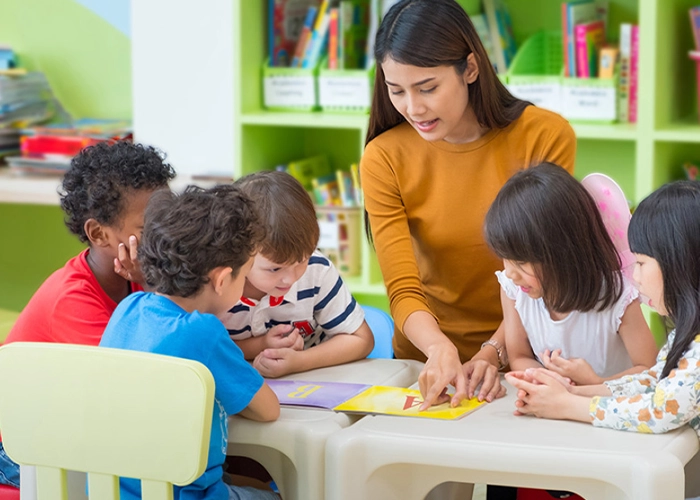
Teaching Methods
Montessori Methods
- Hands-On Learning: Uses tactile learning materials that allow children to learn through experience and manipulation. These materials are designed to be self-correcting, enabling children to learn from their mistakes.
- Guided Discovery: Teachers act as guides, helping children explore and understand concepts independently. They observe students and provide individualized support based on each child’s needs.
- Individualized Pace: Each child progresses at their own pace, ensuring they fully grasp each concept before moving on. This approach helps build confidence and a strong foundation for future learning.
Traditional Methods
- Direct Instruction: Teachers simultaneously deliver lessons to the whole class, ensuring uniform curriculum coverage. This method efficiently teaches large groups of students and ensures consistency in education.
- Textbook-Based Learning: Relies heavily on textbooks and structured resources. These materials are used to provide a clear and consistent framework for learning.
- Paced by Curriculum: Students move through the curriculum at a pace set by the school system, often regardless of individual comprehension levels. This can sometimes lead to gaps in understanding if a student falls behind.
Montessori methods emphasize hands-on, self-paced learning with teacher guidance, while traditional methods focus on direct instruction and a standardized pace for all students.
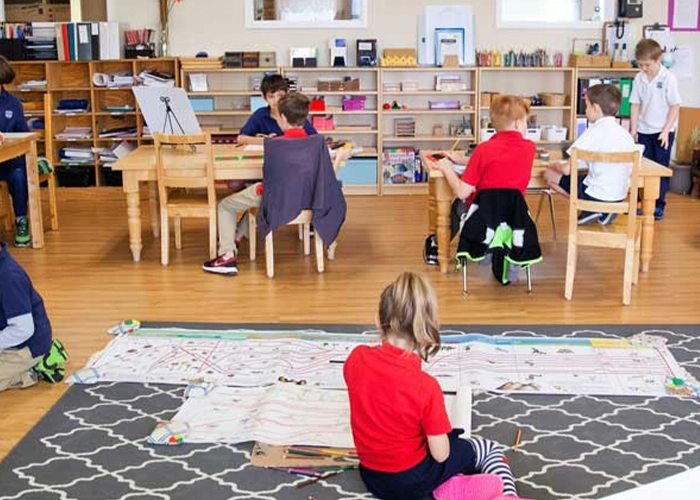

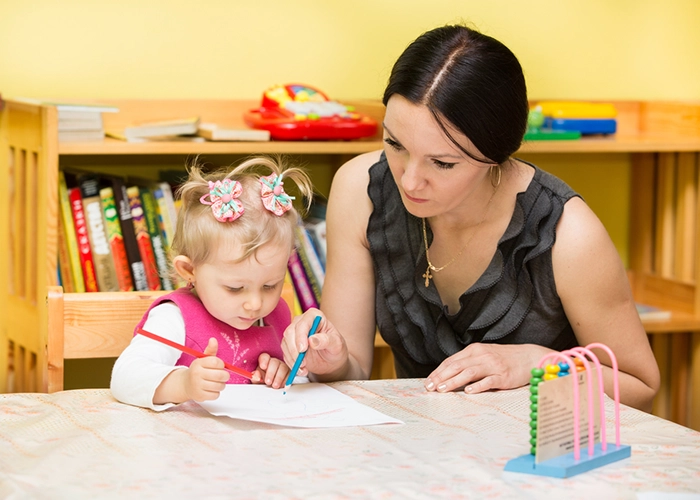
Classroom Environment
Montessori Classroom
- Prepared Environment: Classrooms are designed to be accessible and engaging for children, with materials within easy reach. The environment is carefully arranged to encourage exploration and independent learning.
- Child-Sized Furniture: Furniture and tools are scaled to child size, promoting independence and ease of use. This allows children to take control of their own learning experiences.
- Orderly and Calm: The environment is tidy and peaceful, encouraging concentration and respect. There is a focus on maintaining an atmosphere that supports quiet and focused work.
Traditional Classroom
- Structured Layout: Desks are often arranged in rows facing the teacher, focusing attention on instruction. This traditional setup is designed to facilitate teacher-led lessons and maintain order.
- Teacher’s Domain: The front of the classroom is typically the teacher’s area, reinforcing their central role. This layout supports a clear hierarchy within the school.
- Less Flexible: The environment is less adaptable to individual student needs, focusing more on group instruction. This can sometimes limit the ability to tailor learning experiences to individual students.
Montessori classrooms are designed for child accessibility and independence, while traditional classrooms emphasize structure and teacher-centered layouts.
Daily Schedules
Montessori Schedules
- Flexible Timing: Allows children to spend extended periods on tasks that interest them, fostering deep engagement. This flexibility supports a child’s natural rhythms and encourages prolonged concentration.
- Uninterrupted Work Periods: Schedules are designed to minimize interruptions, supporting sustained focus. This allows children to dive deeply into their work and maintain their concentration.
- Personalized Schedules: Adapts to each child’s needs rather than strictly adhering to a clock. This customized approach ensures that each child can work at their own pace and follow their interests.
Traditional Schedules
- Fixed Schedule: Each subject has a designated time slot covering all curriculum areas. This structure ensures a balanced education and helps students manage their time.
- Regular Transitions: Students transition between subjects and activities at set times, promoting a sense of routine. This predictability can help students feel secure and understand what to expect daily.
- Time Management: Emphasizes managing time effectively and adhering to schedules. This approach helps prepare students for the demands of future academic and professional environments.
Montessori schedules are flexible and personalized, while traditional schedules are fixed and emphasize routine and time management.

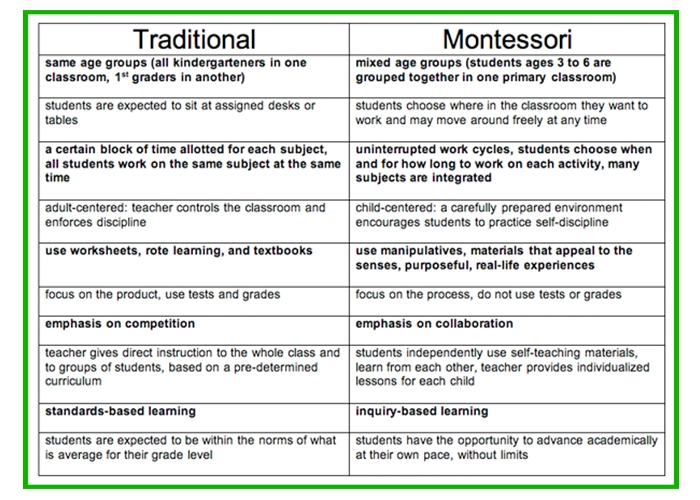
Classroom Composition
Montessori Age Groups
- Mixed-Age Groups: Typically spans three years, allowing younger students to learn from older peers and older students to reinforce their knowledge by teaching younger ones. This system fosters a sense of community and mutual respect.
- Peer Learning: Encourages cooperation and mentorship among students of different ages. Older students often take on leadership roles, helping to build their confidence and responsibility.
- Flexible Progression: Students progress based on their abilities and readiness, not strictly by age. This allows for a more individualized approach to education, meeting each child where they are.
Traditional Age Groups
- Same-Age Groups: Students are grouped by age, ensuring that all are at a similar developmental stage. This can help ensure that instruction is age-appropriate and meets the developmental needs of the students.
- Uniform Learning Pace: All students must progress through the curriculum simultaneously. This uniformity can help ensure that no student is left behind, although it can also present challenges for those who need more time to understand certain concepts.
- Age-Appropriate Socialization: Promotes interaction with peers of the same age, which can facilitate social development. This setup allows students to form friendships and learn social skills with their peers.
Montessori classrooms feature mixed-age groups for peer learning and flexible progression, while traditional classrooms group students by age for uniform teaching and socialization.
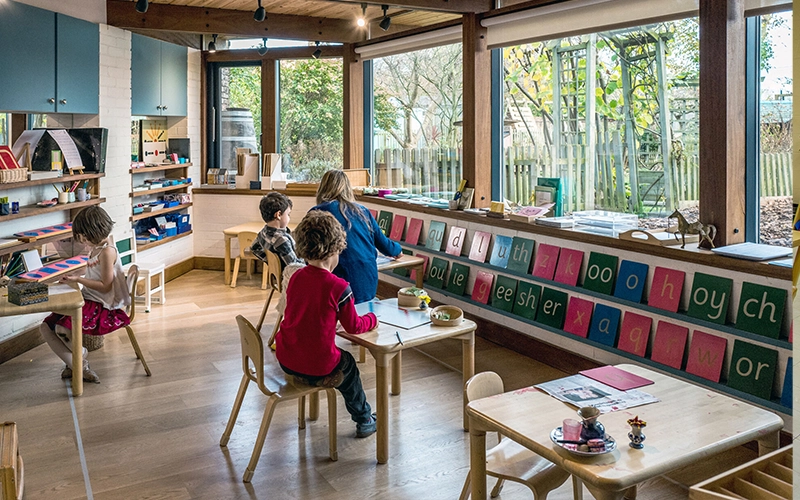
Teacher Qualifications
Montessori Teachers
- Specialized Training: Montessori teachers undergo extensive training specific to the Montessori method, focusing on child development and observational skills. This training helps them create an environment that supports independent learning.
- Facilitator Role: Trained to guide rather than instruct, supporting each child’s learning journey. Montessori teachers observe children and provide support based on their individual needs.
- Continuous Learning: Montessori educators are encouraged to continue their education and personal development. This ongoing learning helps them stay current with best practices and new education research.
Traditional Teachers
- Certified Educators: Teachers are typically certified through state education systems, ensuring they meet standardized qualifications. This certification process ensures teachers have the knowledge and skills to teach effectively.
- Content Experts: Trained to deliver subject-specific content effectively. Traditional teachers often specialize in particular subjects, providing in-depth instruction in their area of expertise.
- Classroom Management: Skilled in maintaining order and managing diverse classroom dynamics. Effective classroom management is crucial for creating a positive and productive learning environment.
Montessori teachers are specially trained to facilitate self-directed learning, while traditional teachers are certified to deliver standardized curricula and manage classrooms.


Discipline Approaches
Montessori Discipline
- Self-Discipline: Encourages children to develop self-control and resolve conflicts independently. This approach helps children learn to manage their behavior and understand the consequences of their actions.
- Respect-Based: Focuses on mutual respect and natural consequences rather than punitive measures. Discipline is seen as a learning opportunity rather than a punishment.
- Positive Reinforcement: Uses positive reinforcement to encourage good behavior and self-regulation. Children are praised and rewarded for their positive actions, which helps to reinforce good behavior.
Traditional Discipline
- Clear Rules: Establishes strict rules and expectations for behavior. This clarity helps students understand what is expected of them and the consequences of not meeting them.
- Punitive Measures: Often relies on consequences like detention or loss of privileges to enforce discipline. These measures are designed to deter negative behavior and maintain order.
- Teacher Authority: Emphasizes the teacher’s role in maintaining discipline and order. Teachers are seen as the primary authority figures in the classroom, responsible for enforcing rules and managing behavior.
Montessori discipline focuses on self-regulation and respect, while traditional discipline emphasizes clear rules and teacher authority.
Cost Considerations
Montessori Costs
- Higher Tuition: Often more expensive due to the need for specialized materials and trained educators. The unique materials and individualized attention in Montessori schools contribute to higher costs.
- Private Funding: Many Montessori schools are privately funded, making them less accessible to all families. The cost of private education can be a barrier for some families.
- Value on Individual Attention: The cost reflects the personalized attention and unique learning environment provided. Montessori education is often seen as an investment in a child’s holistic development.
Traditional Costs
- Public Funding: Public schools are government-funded, making them more affordable and accessible. This funding ensures that all children have access to education.
- Varied Costs: Private traditional schools can also be expensive, but public options provide a cost-effective alternative. Families can choose between public and private education based on their financial situation.
- Economies of Scale: Traditional schools benefit from standardized materials and methods, reducing costs. The larger scale of traditional schools can help keep costs lower for families.
Montessori education tends to be more expensive and privately funded, while traditional education offers more affordable public options due to government funding.
Deciding between Montessori and traditional education depends on your child’s personality, learning style, and your family’s educational values. Each approach has its advantages and can significantly impact your child’s development. Visiting both types of schools and observing their environments can help you make an informed decision that aligns with your child’s needs and your educational philosophy.
Understanding these differences allows you to choose the educational path that best supports your child’s growth and success.
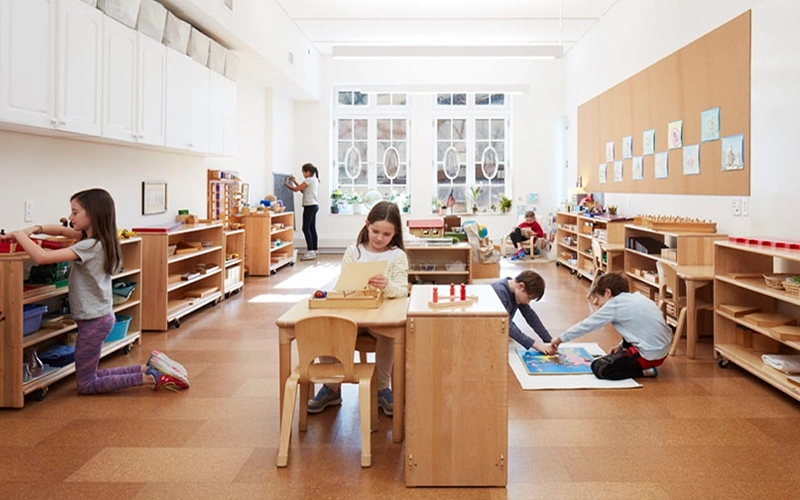
What is the Montessori Method?
When comparing Montessori vs traditional education, it’s essential to understand the fundamental principles of the Montessori method. Dr. Maria Montessori developed this educational approach based on years of scientific observation of children’s learning processes. Here are the basic principles that define the Montessori educational style.
- Child-Centered Learning: The Montessori method places the child at the center of the learning process. Unlike traditional education, where the teacher directs the learning, Montessori classrooms allow children to choose their activities. This approach fosters independence and self-motivation as children engage in tasks that interest them at their own pace. This contrasts traditional classrooms, where the teacher typically leads the instruction and students follow a set curriculum.
- Prepared Environment: Montessori classrooms are carefully prepared to support independent learning. The environment is designed with the child in mind, featuring accessible, hands-on materials that children can explore freely. These materials are self-correcting, meaning that children can learn from their mistakes without direct intervention from the teacher. Traditional classrooms, on the other hand, often rely more on textbooks and direct instruction from the teacher.
- Multi-Age Grouping: A distinctive feature of the Montessori method is multi-age grouping. Montessori classrooms typically include children of different ages, usually spanning three years. This setup encourages peer learning, where younger children learn from older ones, and older children reinforce their knowledge by teaching concepts to younger peers. In contrast, traditional classrooms group children by age, which can limit these beneficial interactions.
- Role of the Teacher: Teachers act more as guides or facilitators in Montessori education than traditional authoritative figures. They observe students to understand their needs and provide individualized support. This approach contrasts with conventional education, where teachers lead the classroom and simultaneously deliver a standardized curriculum to all students.
- Hands-On Learning: Montessori education emphasizes hands-on learning with tactile materials. Children engage in practical activities that help them understand abstract concepts through physical manipulation. This method encourages a deeper understanding and retention of knowledge than traditional education’s reliance on lectures and rote memorization.
- Focus on the Whole Child: The Montessori method focuses on the holistic development of the child, addressing emotional, social, physical, and cognitive growth. Activities promote academic and life skills such as responsibility, cooperation, and problem-solving. Traditional education prioritizes academic achievement and standardized testing over these broader developmental goals.
- Independence and Freedom: Montessori classrooms provide a high degree of freedom within limits. Children can choose their activities and work at their own pace, which helps build decision-making skills and self-discipline. This level of independence is less common in traditional classrooms, where the schedule and activities are often more rigidly structured.
- Respect for the Child: Respect for each child’s individuality is a cornerstone of Montessori education. Teachers respect each child’s unique pace of learning and interests, providing a supportive environment that fosters self-esteem and a love of learning. In traditional settings, the emphasis is more on conformity and meeting set standards.
- Encouragement of Natural Curiosity: The Montessori method encourages natural curiosity by allowing children to explore topics that interest them deeply. This approach leads to more engaged and enthusiastic learners. Traditional education often follows a predetermined curriculum, which can sometimes stifle individual interests and creativity.
- Learning Through Exploration: Montessori education believes in learning through exploration and discovery. Children learn by engaging with their environment, which nurtures their natural desire to understand the world around them. Traditional education often focuses more on theoretical knowledge delivered through textbooks and lectures.
The Montessori method offers a unique, child-centered approach that contrasts sharply with traditional education’s structured, teacher-led model. Understanding these differences is crucial for parents making the Montessori vs. traditional decision for their child’s education.
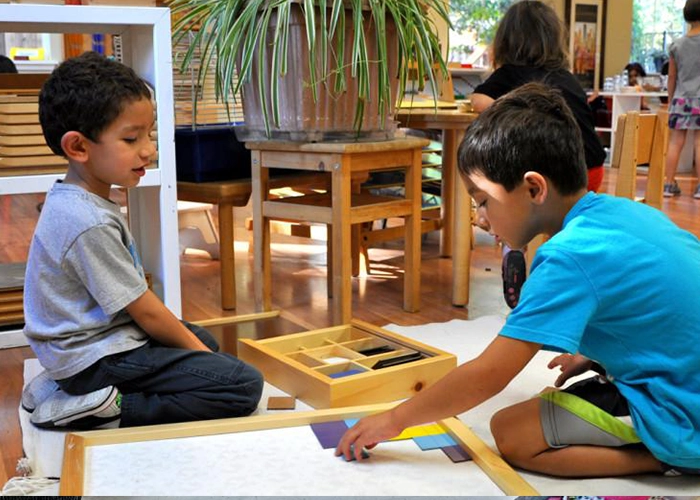
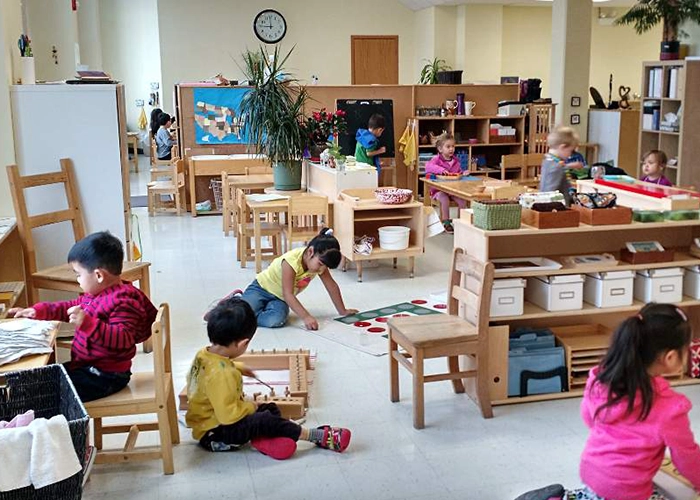
Montessori vs Traditional Play-Based Education
When choosing the best educational approach for your child, it’s essential to understand the differences between Montessori and traditional play-based education. Both methods prioritize the importance of play in learning but implement it differently.
- Structured vs. Unstructured Play: Play is often structured and purposeful in Montessori education. Activities are designed to develop specific skills such as fine motor control, mathematics, or language. Montessori materials are carefully chosen to support learning goals and are used in a specific way to teach particular concepts. In traditional play-based education, play is generally more unstructured. Children can explore and play as they wish, which fosters creativity and social skills. The focus is on allowing children to direct their play without as much emphasis on predefined learning outcomes.
- Role of the Teacher: In Montessori classrooms, teachers guide play by providing appropriate materials and demonstrating their use. They observe children closely and intervene only when necessary to support their learning. This approach helps children develop independence and self-discipline. In traditional play-based settings, teachers take a more hands-off approach, allowing children to play freely. They facilitate play by providing various materials and spaces but do not direct how children should use them. This method encourages children to use their imagination and develop problem-solving skills through social interactions.
- Learning Environment: Montessori environments are carefully prepared with specific materials that promote self-directed learning. Each item in the classroom has a purpose and is designed to teach a particular concept. The environment is calm and orderly, helping children focus and engage deeply with their activities. Traditional play-based classrooms are typically more flexible and dynamic. They are filled with a wide range of toys and materials that children can choose from freely. The environment is often more lively and geared towards stimulating creative play and interaction among children.
- Focus of Activities: Montessori activities are designed to be educational and developmental. Even play activities have a clear learning objective, whether developing motor skills, understanding mathematical concepts, or enhancing language abilities. This structured approach ensures that playtime is also productive learning time. In traditional play-based education, the focus is on play for its own sake. The activities are designed to be fun and engaging, fostering social skills and creativity. While learning outcomes are considered, they are secondary to the primary goal of allowing children to enjoy and explore their play freely.
- Social Interaction: Montessori classrooms encourage social interaction through structured group activities and mixed-age groups. Children learn from and teach each other, fostering a collaborative learning environment. This interaction is guided to ensure it contributes to the child’s development. In traditional play-based settings, social interaction occurs more spontaneously. Children are encouraged to play together and form friendships naturally. This unstructured social play helps children develop essential social skills like sharing, cooperation, and empathy.
Understanding the differences between Montessori and traditional play-based education can help you decide which approach is best for your child. Montessori education integrates structured, purposeful play with clear learning objectives, while traditional play-based education emphasizes unstructured, creative play. Both methods have strengths and can significantly impact your child’s development and love for learning.
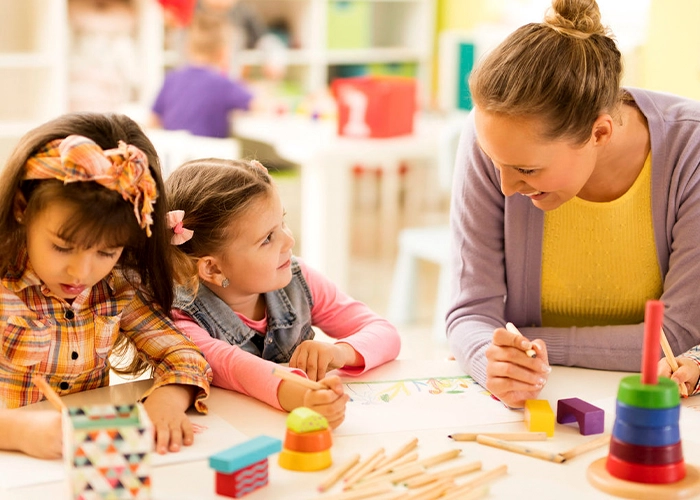
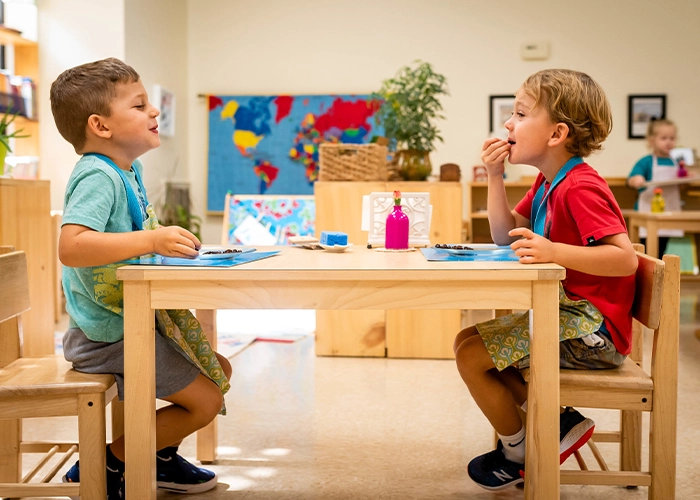
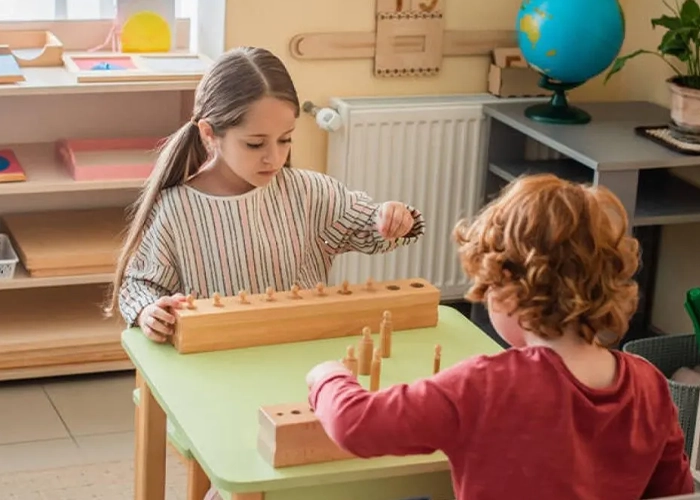
Advantages and Disadvantages of Montessori Education
When deciding between Montessori vs traditional education, weighing the pros and cons of each approach is helpful. Here are the key advantages and disadvantages of Montessori education.
Advantages of Montessori Education
- Child-Centered Learning: Montessori education allows children to lead their learning, fostering independence and self-motivation. Kids choose activities that interest them, which keeps them engaged and excited about learning.
- Individualized Pace: Each child progresses at their own pace, ensuring they fully understand a concept before moving on. This helps build a strong foundation and boosts confidence.
- Hands-On Learning: The use of tactile materials helps children learn through experience. This method can make abstract concepts easier to grasp, enhancing understanding and retention.
- Holistic Development: Montessori education focuses on the whole child, addressing emotional, social, physical, and cognitive development. This well-rounded approach helps children develop essential life skills alongside academic knowledge.
- Mixed-Age Classrooms: Children of different ages learn together, promoting peer learning and social development. Older children mentor younger ones, reinforcing their knowledge and developing leadership skills.
Disadvantages of Montessori Education
- Cost: Montessori schools can be more expensive than traditional schools due to the required specialized materials and teacher training. This can make Montessori education less accessible for some families.
- Less Structure: The flexible, child-led approach might not suit every child. Some children thrive with more structure and clear guidelines, which are common in traditional classrooms.
- Limited Availability: There may be fewer Montessori schools than traditional ones, limiting family options in certain areas.
- Transition to Traditional Schools: Children moving from a Montessori environment to a traditional school might face adjustment challenges due to differences in teaching methods and classroom structure.
- Varied Quality: The quality of Montessori schools can vary widely. Not all schools that use the Montessori name strictly adhere to Dr. Maria Montessori’s original principles, which can impact the effectiveness of the education provided.
Benefits and Drawbacks of Traditional Education
When comparing Montessori vs traditional education, it’s essential to understand the key benefits and drawbacks of traditional education. Here are the main points to consider.
Benefits of Traditional Education
- Structured Curriculum: Traditional education provides a clear and consistent curriculum that all students follow. This structure ensures that essential subjects and skills are covered comprehensively.
- Teacher-Led Instruction: Teachers direct the learning process, providing clear guidance and support. This can benefit students who thrive under more structured guidance and clear expectations.
- Standardized Testing: Traditional schools often use standardized tests to measure student progress. This can help identify areas where students need additional support and ensure they meet educational standards.
- Social Interaction: Students in traditional schools typically learn alongside peers of the same age. This can foster strong social skills and friendships, providing a stable social environment.
- Accessibility: Public traditional schools are widely available and funded by the government, making them accessible to most families. This provides a cost-effective educational option.
Drawbacks of Traditional Education
- Less Individualized Attention: With a standardized curriculum and larger class sizes, students may receive less individualized attention. This can be challenging for those needing extra help or advanced abilities.
- Limited Flexibility: The fixed schedule and standardized approach can limit flexibility. Students might be unable to explore subjects in-depth or learn at their own pace.
- Emphasis on Testing: The focus on standardized testing can sometimes lead to teaching to the test, where the primary goal is passing exams rather than fostering a deeper understanding of the material.
- Less Hands-On Learning: Traditional education relies more on textbooks and lectures, which can be less engaging for some students than hands-on, experiential learning methods.
- One-Size-Fits-All: The uniform approach to education might not suit every child’s learning style or needs. Some students might struggle with the lack of personalized learning opportunities.
When weighing Montessori vs traditional education, it’s crucial to consider the benefits and drawbacks of each. Traditional education offers structured learning, standardized testing, and strong social interaction, making it a reliable choice for many families. However, it may lack the individualized attention, flexibility, and hands-on learning experiences that Montessori education provides. Understanding these factors can help you make the best decision for your child’s education.
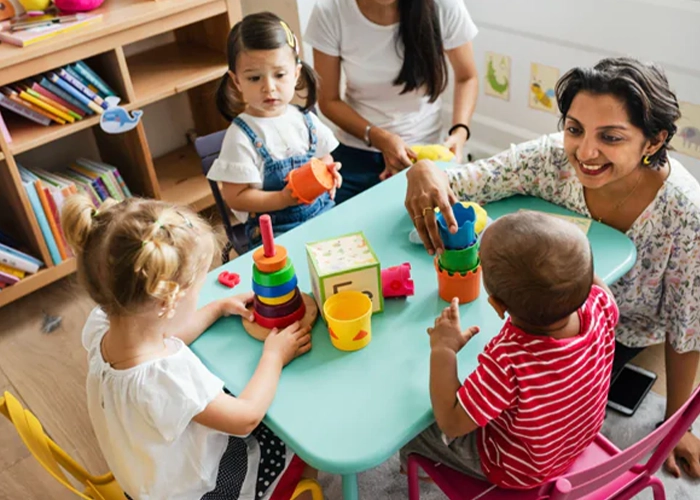

Choosing between Montessori vs traditional education is a significant decision that depends on your child’s unique needs, learning style, and your family’s educational values. Montessori education offers a child-centered, hands-on approach that fosters independence and holistic development. On the other hand, traditional education provides structured learning, standardized testing, and strong social interaction.
Both educational methods have their own strengths and challenges. Visiting both types of schools, observing the environments, and considering how each aligns with your child’s personality and learning preferences can help you make an informed decision. Ultimately, the goal is to select an educational path that supports your child’s growth, happiness, and success. By understanding the key differences and advantages of Montessori vs traditional education, you can choose the best option for your child’s future.
